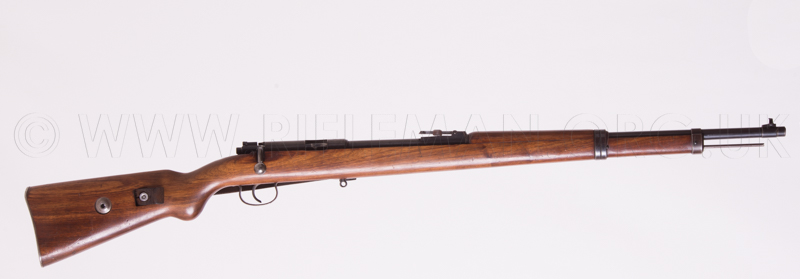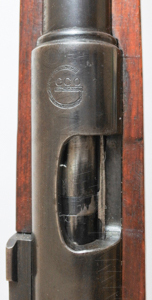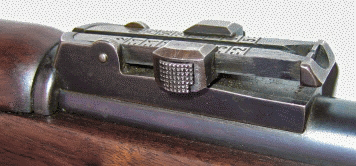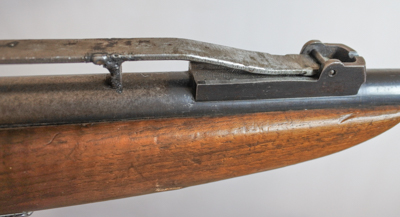The German MAUSER "Deutsche Sportmodell" Training Rifle
and the K98a with a .22RF conversion unit
See also: three service models of Mauser Kar98 rifle, including two sniping versions
and the Mauser style "Dreibund-Jugendkarabiner" training rifle.
The Mauser bolt-action .22 LR rimfire rifle shown first as an example on this page was manufactured by the " Geco" company (Gustav Genschow & Co.), one of many companies sub-contracting for the production of these allegedly sporting rifles ( the German Government - post the First World War - were officially restricted to the production of only sporting arms; military weapon manufacture was more or less forbidden by the Allies . Some years on, the sporting rifles came to bear more than a passing resemblance to the old German service rifle). This new miniature calibre Mauser rifle became known as the DSM-34, by virtue of the " Deutsche Sportmodell" designation and the 1934 year of introduction. The DSM became one of the most common of the German "training" rifles and, as was the 1939 following design KKW rifle ( Klein Kaliber - Wehrsportgewehr ), was modelled loosely upon the Gewehr 98 rifle genre. The DSM could not be fixed with a bayonet, but the immediately pre-W.W.II design KKW was so enabled.
Here is an opportunity to view every aspect of the rifle.
The next two images can be rotated and zoomed, either as initially loaded or full-screen for higher definition.
Slide cursor < > to rotate, and Click to zoom.
Left: a contemporary Geco advertisement .................. Right: the motif on the rifle
......................
The fore section with front barrel band forming a nose-cap of sorts, the fore-sight arrangement,
and the plain cleaning rod with just a screw-slot at the front end.
Left and centre: the tangent-leaf rear-sight calibrated for 25 to 200 metres
............
Right: the action
Below left: the barrel stamping
" Deutsche Sportmodell"
and right: the serial number " 3634 " on barrel and receiver ring
along with the proof and calibre mark for 5.4 mm
................
The bolt from above
At the end of the War in 1945, the French Government took over the Mauser factories
and these training rifles were still in production for a short while.
Before long, all the tooling was removed to France along with all the factory stocked parts as yet unassembled.
The rifles were built up in France in the MAS factory, and bore the MAS name thereafter.
What might a young farmer wanting a vermin rifle do when all he has to hand is an old training rifle?
One perhaps needs to bear in mind that this was probably done not long after WWII,
when such arms were rather more common, and of little relative value.
We have already shown a rare telescoped DSM34, but not one like this!
Enter: one farmer, one old Mauser Sportmodell, one telescopic sight (unseen),
two feet of mild-steel bar, one bolt, two self-tapping screws, ....... and an arc welder.
Will British inventiveness never cease?
Perfect; it says its a German sporting model!
First, remove the barrel's tangent rear-sight leaf, .......... then set to work.
..........
While the work is in progress we notice, for the first time,
that the rifle has markings that say
" KAL .22 LANG FÜR BÜSCHEN "
and
" GERMANIAWAFFENWERK A.-G. ZELLA-MEHLIS"
So now we know where it came from, and our ICI war issue cartridges will be fine.
And it says its for work in the bush - just the thing
..........
Hmm. May need to practice welding technique before doing another.
There. Look out rooks and rabbits.
We promised mention of the single-shot .22RF coversion unit
fitted to a 7.92 x 57mm Mauser Service rifle,
and illustrate a 1914 carbine fitted with such a conversion unit.
The "3D" image below can be rotated, zoomed and viewed full-screen
At one point in the imagery, the adapter can be seen being slid into place,
and turned ninety degrees to lock it into position with the bolt open,
and then the bolt being closed.
The centre-fire bolt-head of the full-bore Kar98 for eventual comparison.
Close-up photographs of the conversion unit will follow soon.
See also the Kar98 .22RF magazine-fed conversion unit for the German service rifle,
For the most comprehensive record of small-bore Mauser training and sporting rifles,
read the superb Collector Grade Publications book by Jon Speed, unsurprisingly entitled
" MAUSER SMALLBORES - Sporting target and Training Rifles".
For details, see RECOMMENDED READING
See also the Kar98 .22RF magazine-fed conversion unit for the German Service rifle,
and the wartime Anschutz Büscher 4mm calibre Mauser training rifle.
or : three service models of Mauser Kar98 rifle, including two sniping versions
There is also a Chronology of Enfield genre Training Rifles, Adapters & Cartridges
See this website's Raison d'être














